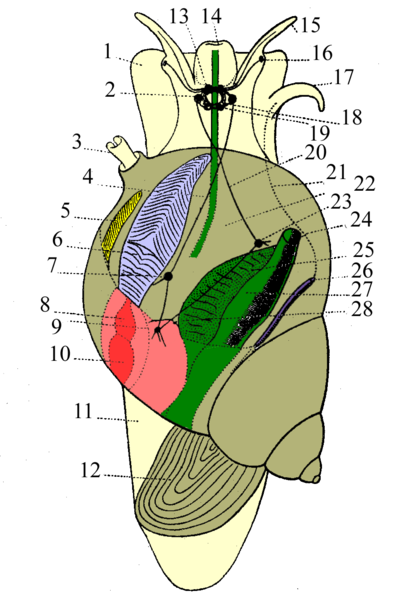
Facts
Don't have time to devour the whole webpage this minute? Well...Here are some general points and some fun facts about Bithynia tentaculata.
-
B. tentaculata is in the phylum mollusca. Some other organisms in this phylum are the cephalopods, bivalves and chitons.
- B. tentaculata is
a “river snail” that breathes using gills or its
ctenidium.
- B. tentaculata like all gastropods have
undergone torsion, or a 180° twist of its body
cavity.
- B. tentaculata grazes for food using
its radula or filter feeds using its gills.
- B. tentaculata lays numerous eggs in
double rows.
For information on the coolest fungi around visit the webpage of a University of La Crosse professor Tom Volk.
 GASTROPOD ANATOMY(Prosobranch)
GASTROPOD ANATOMY(Prosobranch)
Peach color - body
Brown - shell and operculum
Green - digestive system
Light violet - gills
Yellow -osphradium
Red - heart
1. foot
2. cerebral ganglion
3. pneumostome
4. upper
commissura
5. osphradium
6. gills
7. pleural ganglion
8. atrium of heart
9. visceral ganglion
10. ventricle of heart
11. foot
12. operculum
13. brain
14. mouth
15. tentacle (chemosensory)
16. eye
17. penis (everted, normally internal)
18. esophageal nerve ring
19. pedal ganglion
20. lower commissura
21. vas deferens
22. pallial cavity / mantle
cavity / respiratory cavity
23. parietal ganglion
24. anus
25. hepatopancreas
26. gonad
27. rectum
28. nephridium
More facts about Bithynia tentaculata...
-
Inactivity is a typical stress response of the faucet snail.
-
“The faucet snail has the potential to be a good biomonitor for contaminants such as Cd, Zn, and MeHg because there are good correlations between environmental concentrations and snail tissue concentrations with respect to these toxic compounds” (Kipp and Benson 2010).
-
Shells of young snails are thin and transparent and those of adults are thick, opaque and corroded (Wächtler 2001).

Photo by
Jan Delsing
![]()
Return to the Home page